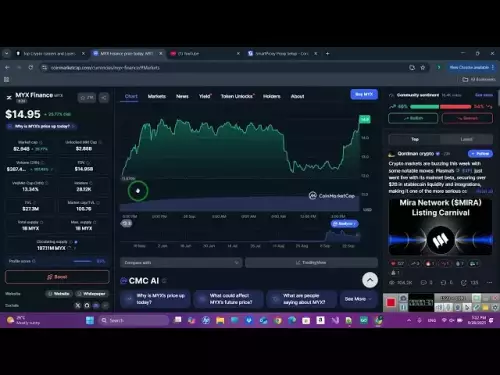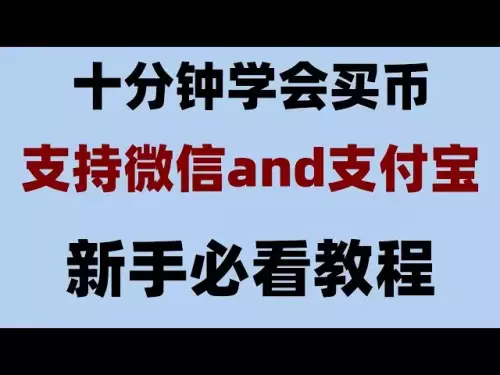-
 bitcoin
bitcoin $109547.008142 USD
0.04% -
 ethereum
ethereum $4011.838726 USD
-0.05% -
 tether
tether $1.000402 USD
-0.01% -
 xrp
xrp $2.798606 USD
0.88% -
 bnb
bnb $970.877944 USD
1.39% -
 solana
solana $202.237275 USD
-0.95% -
 usd-coin
usd-coin $0.999673 USD
0.00% -
 dogecoin
dogecoin $0.229294 USD
-1.15% -
 tron
tron $0.336370 USD
-0.45% -
 cardano
cardano $0.777260 USD
-1.66% -
 hyperliquid
hyperliquid $45.503019 USD
1.73% -
 ethena-usde
ethena-usde $1.000362 USD
0.01% -
 chainlink
chainlink $20.785303 USD
-1.10% -
 avalanche
avalanche $28.755822 USD
-0.11% -
 stellar
stellar $0.358303 USD
-0.48%
How to use moving averages in crypto trading?
Moving averages help crypto traders identify trends by smoothing price data, with EMA offering quicker signals and SMA providing smoother trends—combining them with other indicators improves accuracy.
Jul 16, 2025 at 08:01 pm

Understanding Moving Averages in Crypto Trading
Moving averages (MAs) are among the most commonly used technical indicators in cryptocurrency trading. They help smooth out price data over a specific time period, offering traders a clearer view of trends. The green-highlighted key point here is that moving averages reduce noise and volatility, making it easier to identify potential entry and exit points.
There are several types of moving averages, including Simple Moving Average (SMA), Exponential Moving Average (EMA), and Weighted Moving Average (WMA). Each has its own calculation method and use case. For example, EMA gives more weight to recent prices, which can be particularly useful in fast-moving crypto markets.
Selecting the Right Timeframe for Your Strategy
Choosing the correct timeframe is crucial when applying moving averages to crypto trading. Traders often use short-term MAs like 9-day or 20-day EMAs for scalping or intraday trading, while longer-term MAs such as 50-day or 200-day SMAs are better suited for swing or position trading.
The green-highlighted key consideration is aligning your MA timeframe with your trading strategy and risk tolerance. Day traders may focus on 5-minute or 15-minute charts with shorter MAs, whereas long-term investors might rely on daily or weekly charts with longer-period MAs to filter out short-term volatility.
Identifying Trend Direction Using Crossovers
One of the most popular strategies involving moving averages is the crossover method. This involves using two MAs — a short-term and a long-term — to signal trend changes. When the short-term MA crosses above the long-term MA, it’s considered a bullish signal (golden cross); conversely, when it crosses below, it’s seen as bearish (death cross).
For instance, many traders watch the 50-day EMA crossing over the 200-day EMA on Bitcoin's chart as a strong indicator of market sentiment. It’s important to note that green-highlighted confirmation from volume and other indicators increases the reliability of these signals.
Here’s how you can set up a basic crossover strategy:
- Choose a short-term and long-term EMA (e.g., 9 and 21).
- Apply both EMAs to your chart.
- Look for crossovers during periods of consolidation or trending moves.
- Confirm the crossover with increasing volume or RSI divergence.
Using Moving Averages as Dynamic Support and Resistance Levels
In addition to identifying trends, moving averages also act as dynamic support and resistance levels. In an uptrend, the price often finds support near the rising MA line, while in a downtrend, the falling MA acts as resistance.
A common practice among traders is to watch for bounces off the 20-day or 50-day SMA as potential buying opportunities in an uptrend. Similarly, in downtrends, rejections at the 200-day SMA can indicate strong resistance.
The green-highlighted benefit of this approach is that it allows traders to enter trades with the trend, reducing the likelihood of being caught in false breakouts. However, it’s essential to combine this with candlestick patterns or momentum indicators for better accuracy.
Here’s how to apply this technique effectively:
- Identify the dominant trend using higher timeframes (e.g., daily or 4-hour charts).
- Overlay key MAs like 20, 50, or 200 on the chart.
- Watch how the price interacts with these levels during pullbacks.
- Enter trades when the price bounces off the MA with increased volume.
Combining Moving Averages with Other Indicators
Relying solely on moving averages can lead to misleading signals, especially in sideways or choppy markets. Therefore, green-highlighted successful traders often combine MAs with other tools such as RSI, MACD, or Bollinger Bands to increase the probability of accurate trade setups.
For example, if the price is above the 50-day EMA and the RSI is above 50, it could confirm a bullish trend. Conversely, if the price is below the 200-day SMA and the MACD line crosses below the signal line, it reinforces a bearish outlook.
To implement a combined strategy:
- Select one or two additional indicators alongside your chosen MAs.
- Use RSI to detect overbought (>70) or oversold (
- Employ MACD to confirm trend direction and momentum shifts.
- Filter out low-probability trades where indicators contradict each other.
Backtesting and Adjusting Moving Average Parameters
Before applying any moving average strategy in live trading, green-highlighted backtesting is essential to validate its effectiveness. Historical performance can reveal whether a particular MA setup works well with a given cryptocurrency.
Many platforms like TradingView or Binance’s native tools allow users to test different MA combinations on past price data. By adjusting parameters like the length of the MA or the type (SMA vs EMA), traders can fine-tune their systems for optimal results.
Key steps for effective backtesting include:
- Define clear entry and exit rules based on MA signals.
- Test across multiple market cycles and cryptocurrencies.
- Record win/loss ratios and adjust parameters accordingly.
- Avoid curve-fitting by testing across different assets and timeframes.
Frequently Asked Questions
Q: Can moving averages be used effectively in highly volatile crypto markets?Yes, but they should be used cautiously. Since moving averages lag behind price action, green-highlighted volatility can cause delayed signals, leading to missed opportunities or false entries. Combining them with volatility filters like Bollinger Bands or ATR can improve accuracy.
Q: Should I use the same moving average settings for all cryptocurrencies?No. Different cryptocurrencies have varying liquidity and volatility profiles. For example, Bitcoin may respond better to a 50/200 EMA strategy, while altcoins might require shorter MAs like 9/21 due to faster price swings. Always test and adapt your settings per asset.
Q: How do I choose between Simple and Exponential Moving Averages?It depends on your trading style. If you want green-highlighted quicker responses to recent price changes, use EMA. If you prefer smoother, less reactive signals, go with SMA. Many traders use a mix of both to capture different aspects of the trend.
Q: Are moving averages suitable for automated trading bots?Absolutely. Many algorithmic trading systems incorporate moving averages as part of their logic. However, ensure the bot includes green-highlighted robust risk management features, as pure MA-based systems can suffer during ranging or fakeout scenarios.
Disclaimer:info@kdj.com
The information provided is not trading advice. kdj.com does not assume any responsibility for any investments made based on the information provided in this article. Cryptocurrencies are highly volatile and it is highly recommended that you invest with caution after thorough research!
If you believe that the content used on this website infringes your copyright, please contact us immediately (info@kdj.com) and we will delete it promptly.
- BlockchainFX, Binance Coin, Cardano: Decoding the Crypto Landscape in 2025
- 2025-09-29 04:45:12
- Cathie Wood, Bitcoin, and the Future of Monetary Standards: A New York Perspective
- 2025-09-29 04:25:17
- Crypto Presales Under the Microscope: BlockDAG, HYPER, and the Hunt for the Next Big Thing
- 2025-09-29 04:25:17
- Ethereum Bulls Eye $4,000: Is the Rally Sustainable?
- 2025-09-29 05:05:14
- Aster Price Surge: Bullish Breakout or Falling Wedge Fiasco?
- 2025-09-29 04:45:12
- Aptos Price Prediction: Will the Velociraptor Upgrade Trigger a Rally?
- 2025-09-29 04:50:01
Related knowledge

Practical parameter settings for a Bitcoin multi-timeframe moving average system
Sep 18,2025 at 10:54pm
Optimizing Timeframe Combinations for Bitcoin Trading1. Selecting appropriate timeframes is crucial when building a multi-timeframe moving average sys...

How can I filter out false breakouts in Dogecoin high-frequency trading?
Sep 22,2025 at 01:00am
Understanding False Breakouts in Dogecoin Trading1. A false breakout occurs when Dogecoin's price appears to move beyond a defined support or resistan...

Techniques for identifying tops and bottoms in the Bitcoin on-chain NVT model
Sep 20,2025 at 07:54pm
Understanding the NVT Model in Bitcoin Analysis1. The Network Value to Transactions (NVT) ratio is often described as the 'P/E ratio' of the cryptocur...

What does the surge in open interest in Bitcoincoin futures mean?
Sep 20,2025 at 11:18pm
Understanding the Surge in Dogecoin Futures Open Interest1. A surge in open interest within Dogecoin futures indicates a growing number of active cont...

How can I use the Ethereum USDT premium to gauge market sentiment?
Sep 18,2025 at 11:55pm
Understanding the Ethereum USDT Premium1. The Ethereum USDT premium refers to the price difference between USDT (Tether) traded on Ethereum-based plat...

What should I do if Ethereum staking yields decline?
Sep 20,2025 at 06:18am
Understanding the Causes Behind Declining Ethereum Staking Yields1. The Ethereum network transitioned to a proof-of-stake consensus mechanism with the...

Practical parameter settings for a Bitcoin multi-timeframe moving average system
Sep 18,2025 at 10:54pm
Optimizing Timeframe Combinations for Bitcoin Trading1. Selecting appropriate timeframes is crucial when building a multi-timeframe moving average sys...

How can I filter out false breakouts in Dogecoin high-frequency trading?
Sep 22,2025 at 01:00am
Understanding False Breakouts in Dogecoin Trading1. A false breakout occurs when Dogecoin's price appears to move beyond a defined support or resistan...

Techniques for identifying tops and bottoms in the Bitcoin on-chain NVT model
Sep 20,2025 at 07:54pm
Understanding the NVT Model in Bitcoin Analysis1. The Network Value to Transactions (NVT) ratio is often described as the 'P/E ratio' of the cryptocur...

What does the surge in open interest in Bitcoincoin futures mean?
Sep 20,2025 at 11:18pm
Understanding the Surge in Dogecoin Futures Open Interest1. A surge in open interest within Dogecoin futures indicates a growing number of active cont...

How can I use the Ethereum USDT premium to gauge market sentiment?
Sep 18,2025 at 11:55pm
Understanding the Ethereum USDT Premium1. The Ethereum USDT premium refers to the price difference between USDT (Tether) traded on Ethereum-based plat...

What should I do if Ethereum staking yields decline?
Sep 20,2025 at 06:18am
Understanding the Causes Behind Declining Ethereum Staking Yields1. The Ethereum network transitioned to a proof-of-stake consensus mechanism with the...
See all articles









































































